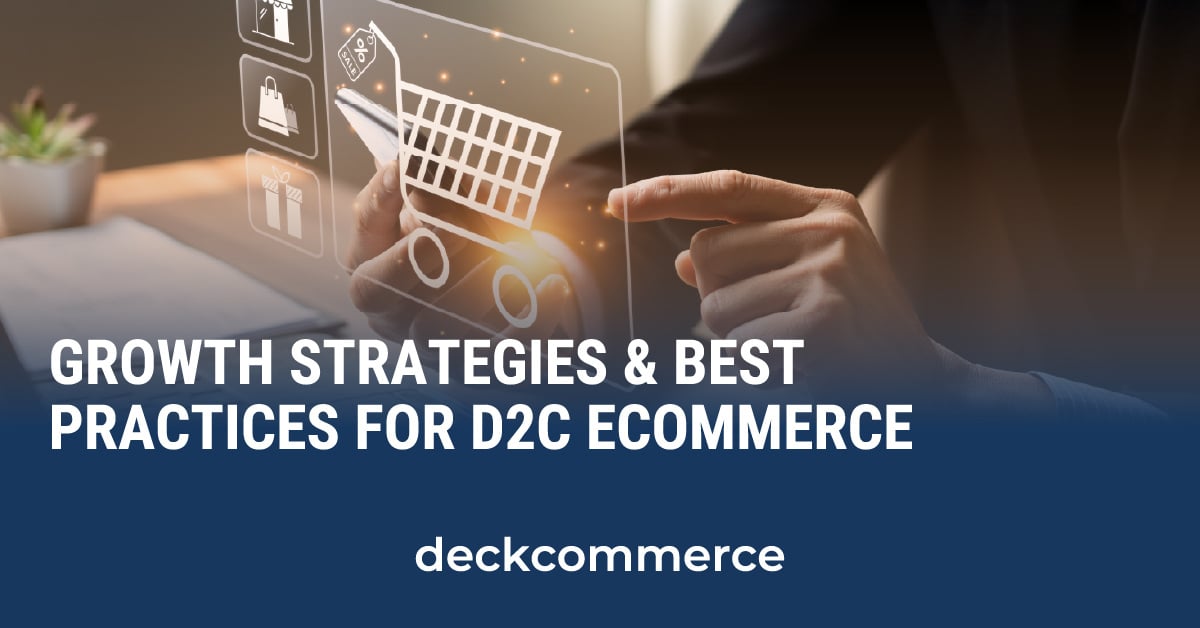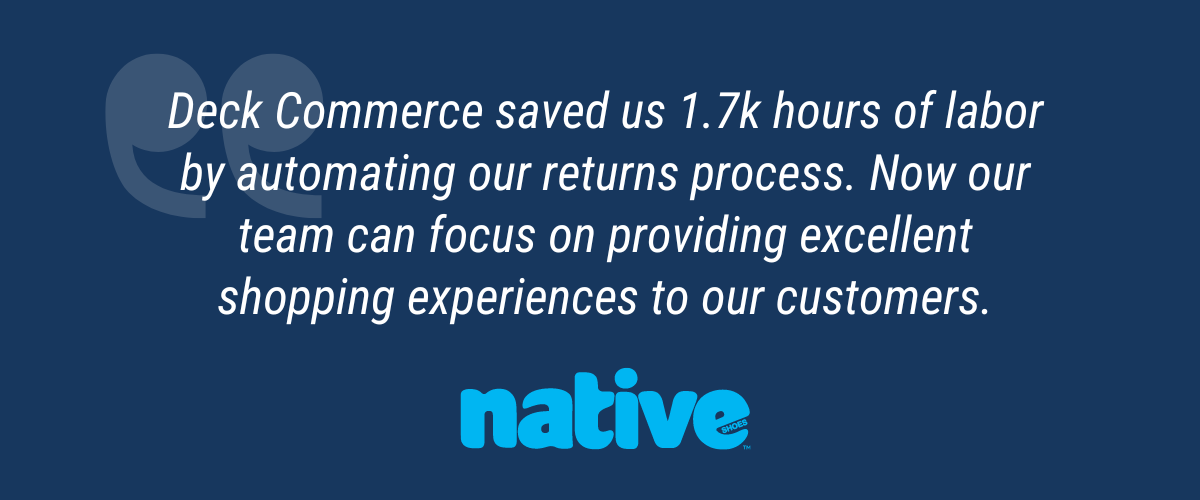
In modern direct-to-consumer (D2C) eCommerce, brands are increasingly taking control of their sales channels, bypassing traditional intermediaries to connect directly with their customers.
This shift not only transforms how products are marketed and delivered but also redefines the relationship between brands and their consumer base. As D2C continues to grow in popularity, fueled by advancements in technology and changes in consumer behavior, the stakes for companies in this space have never been higher.
Navigating the D2C eCommerce landscape requires more than an innovative product or a catchy marketing campaign; it demands a robust strategy integrating advanced technology and thorough growth planning.
From leveraging powerful eCommerce platforms to integrating sophisticated order management systems, technology stands at the heart of successful D2C operations, enabling brands to manage complex logistics, personalize customer interactions, and scale efficiently.
In this blog, we'll explore essential strategies and best practices that can help D2C brands not only survive but thrive in this competitive market.
The Rise of D2C eCommerce: Revolutionizing Retail from the Ground Up

Direct-to-consumer (D2C) eCommerce represents a fundamental shift in how products reach consumers.
Unlike traditional retail models often involving multiple intermediaries such as wholesalers, distributors, and retailers, D2C cuts out the middlemen, allowing brands to sell directly to consumers. This model enhances the brand's control over its marketing, sales, and distribution processes and allows for deeper customer relationships and more personalized shopping experiences.
D2C eCommerce Examples
The rise of D2C brands has been meteoric across various industries, from fashion and beauty to food and technology. Companies like Warby Parker, Glossier, and Casper have disrupted their respective sectors by directly engaging with their customer base through online platforms.
This direct interaction not only provides these brands with invaluable first-hand consumer data but also enables them to rapidly adapt to changing consumer preferences and market conditions.
The Impact on Traditional Retail
Customers now expect a seamless, personalized shopping experience that D2C brands are uniquely positioned to provide. The convenience of shopping directly from home and the ability to interact with brands via social media and other digital channels has shifted consumer expectations towards a more engaged and responsive buying experience.
As a result, traditional retailers are forced to reconsider their business models and find new ways to connect with their customers in this increasingly digital world.
Building a Strong Foundation: Key Components of D2C Success
Two fundamental components are pivotal in setting up for success: selecting the right eCommerce platform and crafting a distinctive brand identity paired with an outstanding customer experience.
Choosing the Right D2C eCommerce Platform
The backbone of any D2C business is its eCommerce platform. This technology hosts your online store and integrates various functionalities that handle everything from marketing and sales to customer service and inventory management.
Selecting the right platform is critical, as it needs to scale with your business growth, accommodate your specific product needs, and integrate seamlessly with other tools like CRM systems, payment processors, and shipping services.
When evaluating potential eCommerce platforms, consider factors such as:
- Configurability: Can you tailor the platform to your brand’s specific needs?
- Scalability: Will the platform grow with your business without performance issues?
- Integration capabilities: Does it easily integrate with other software crucial for your operations?
- User experience: Does it offer a streamlined and intuitive admin interface for your team?
- Support and community: Is there robust support and a community that can offer advice and solutions?
Platforms like Shopify, BigCommerce, Salesforce Commerce Cloud, and Adobe Commerce often come up in discussions about D2C because of their robust features, scalability, and extensive integration capabilities.
Each platform has strengths, and choosing the right one depends heavily on your business needs and long-term goals.
Brand Identity and Enhanced Customer Experience

In a market where consumers are bombarded with choices, having a strong brand identity helps you stand out. Your brand identity is more than just your logo or color scheme; it’s the entire essence of your brand.
This identity should resonate through all your customer touchpoints to create a cohesive and memorable experience.
Key strategies to enhance brand identity and customer experience include:
- Consistency across channels: Ensure that your brand voice and aesthetics are consistent across all platforms, from your website and social media to packaging and customer service.
- Personalization: Use customer data to tailor experiences and make interactions feel more personal and engaging. This can range from personalized product recommendations to customized email marketing campaigns.
- Storytelling: Connect with customers through compelling storytelling that aligns with your brand values and mission. This helps to build emotional connections and brand loyalty.
- Feedback loop: Implement mechanisms to gather and act on customer feedback, which will not only improve the product or service but also show customers that their opinions are valued.
Integrating Technology for Operational Success
.png?width=600&height=400&name=Integrations%20-%20Website%20(1).png)
A cohesive technology stack is fundamental for D2C brands aiming to scale efficiently and maintain competitiveness. This stack typically includes eCommerce platforms, customer relationship management (CRM) systems, analytics tools, marketing automation, and importantly, an order management system.
Together, these technologies streamline operations, from customer acquisition to fulfillment and after-sales support.
The benefits of an integrated tech stack include:
- Unified Data: Centralizing data across platforms improves accuracy and provides a single source of truth for all operational decisions.
- Automated Workflows: Automation of routine tasks reduces the risk of human error and frees up resources for strategic initiatives.
- Enhanced Customer Insights: Integrated systems provide a deeper understanding of customer behaviors and preferences, enabling more targeted marketing and product development.
- Agility and Flexibility: With a modular tech stack, businesses can quickly adapt to market changes or integrate new tools without disrupting existing operations.
The Role of an Order Management System
An Order Management System (OMS) such as Deck Commerce is the linchpin of a successful D2C eCommerce operation, anchoring the integrated tech stack that drives modern brands.
Its central role in streamlining complex processes—from order processing and inventory management to customer service—makes it an indispensable tool. An order management system offers a comprehensive solution that ensures operational tasks are managed with precision and efficiency and seamlessly connects with other critical systems within the tech stack.
This integration is crucial for D2C brands striving to maintain a competitive edge, enabling them to deliver exceptional customer experiences while optimizing their backend operations.
Here’s where an OMS can make the biggest impact on D2C eCommerce strategies.
|
Functionality |
Impact |
|
Streamlined Order Processing |
Automates the entire order lifecycle from placement to fulfillment, minimizing errors and speeding up processing, ensuring prompt and accurate delivery to customers. |
|
Real-Time Inventory Management |
Provides real-time visibility into inventory levels across all sales channels, crucial for preventing stockouts or excess inventory. |
|
Seamless Integration with Other Platforms |
Integrates seamlessly with various eCommerce platforms, CRM systems, and financial software, enhancing the flow of data and operational efficiency across systems. |
|
Enhanced Customer Service |
Offers comprehensive order and customer data for quick issue resolution and superior customer experience. Supports self-service capabilities for checking order statuses and initiating returns. |
|
Scalability and Configurability |
Designed to scale with the evolving needs of D2C brands, offering configurable workflows and features that adapt to changing business requirements. |
|
Ensures a consistent shopping experience across all channels, crucial for modern consumer expectations. |
|
|
Advanced Returns Management |
Streamlines the returns process, making it easy for customers to return products and for retailers to reintegrate returned goods into inventory or process replacements. |
|
Order Orchestration |
Coordinates and optimizes the flow of orders through various stages of fulfillment, ensuring efficient operations and timely delivery. |
Driving Growth: Customer Acquisition and Conversion Optimization
.png?width=800&height=600&name=Untitled%20(800%20%C3%97%20600%20px).png)
Effective customer acquisition and conversion optimization strategies are key to driving growth and building a sustainable business model.
Combining robust digital marketing techniques with advanced personalization tactics, D2C brands can attract and convert customers more efficiently.
Effective Use of Digital Marketing
To reach potential customers where they are most likely to engage, D2C brands must leverage a mix of digital marketing strategies:
- Content Marketing: Creating valuable content that addresses customer needs and positions the brand as a thought leader in its niche.
- SEO: Optimizing website content to ensure high visibility in search engine results, attracting organic traffic.
- Paid Advertising: Utilizing paid search and social media ads to target specific demographics and drive traffic to the brand’s website.
Social Media and Influencer Marketing
Social platforms and influencers provide powerful channels to amplify brand reach and credibility:
- Social Media Marketing: Engaging with customers on platforms like TikTok, YouTube, Instagram, Facebook, and Twitter to build community and promote products.
- Influencer Partnerships: Collaborating with influencers who resonate with the brand’s target audience to gain endorsements that carry weight and drive sales.
Conversion Optimization Techniques
.png?width=1200&height=627&name=Shoptalk%20Ads%20(4).png)
Once potential customers land on your site, the goal shifts towards converting them into paying customers through strategic optimizations and personalization.
Optimize Website Design and Usability
To maximize conversions, your eCommerce site must be intuitively designed and user-friendly.
Key elements to focus on include:
- Clear Navigation: Ensure your site layout is straightforward, allowing customers to easily find what they want.
- Fast Loading Times: Optimize your website's speed to prevent customer drop-offs due to slow-loading pages.
- Mobile Optimization: With the increasing prevalence of mobile shopping, ensure your site is fully optimized for mobile devices, providing a seamless shopping experience on any device.
Optimizing Storefront Pages
Enhancing your storefront page is essential for capturing customer interest and facilitating conversions.
By offering a variety of options that cater to different purchasing preferences and circumstances, customers are more likely to find a solution that suits their needs, significantly increasing the likelihood of making a purchase.
- Estimated Delivery Dates: Display estimated delivery dates prominently to set clear expectations for delivery timelines.
- Local Store Inventory for BOPIS and Curbside Pickup: Integrate real-time inventory data to show product availability at local stores, supporting Buy Online, Pick Up In-Store (BOPIS), and curbside pickup options.
- Ship-to-Store Options: Offer customers the option to ship their online orders to a local store of their choice, which can be an enticing incentive for those who prefer in-person pickups.
- Multiple Payment Options: To cater to different customer preferences, include a variety of payment methods, including digital wallets, credit cards, and innovative solutions like Buy Now, Pay Later (BNPL).
Personalization Tactics
Leverage data-driven insights to create a tailored shopping experience that increases the likelihood of conversion:
- Personalized Product Recommendations: Use algorithms to suggest products based on a customer’s browsing history and previous purchases.
- Dynamic Content: Display content that adjusts based on the user’s behavior, demographics, and other personal data to make their shopping experience unique and targeted.
- Targeted Offers: To encourage purchases, provide special deals and promotions based on user activity and shopping patterns.
Implementing these techniques can enhance the user experience, personalize customer interactions, and optimize your eCommerce site for higher conversions, ultimately leading to increased sales and customer loyalty.
Customer Retention and Loyalty Programs
In D2C eCommerce, acquiring customers is only part of the battle; retaining them is crucial for sustained growth and profitability. Effective customer retention strategies and loyalty programs are essential in encouraging repeat purchases and building enduring customer relationships.
Creating Compelling Loyalty Programs

Loyalty programs that go beyond traditional points and rewards systems can create lasting engagement and encourage continuous interaction with the brand.
Here are strategies for crafting compelling loyalty programs:
- Tiered Rewards: Develop a tiered system in which customers earn more significant rewards as they reach higher spending thresholds. This will encourage more frequent purchases and larger order values.
- Exclusive Benefits: Offer exclusive benefits such as early access to new products, special members-only promotions, or free shipping, which add significant value to the customer experience.
- Engagement-Based Points: Reward customers for various forms of engagement with the brand, such as writing reviews, sharing products on social media, or participating in community events, fostering a deeper connection with the brand. An OMS is the best way to track loyalty points, even after returns–helping to maintain accuracy and customer trust.
Provide Exceptional Customer Support

Customer support is pivotal in retention by resolving issues efficiently and fostering a positive post-purchase experience.
Here’s how exceptional customer service can enhance customer loyalty:
- Responsive Support: Ensure that customer service is easily accessible across multiple channels, including live chat, email, and phone. Quick and helpful responses can significantly impact customer satisfaction.
- Proactive Problem Solving: Implement customer service tools that anticipate and solve problems before they affect the customer, such as notifying customers of delays or potential issues with their orders.
- Personalized Interactions: Effectively leveraging customer data is crucial for enhancing support interactions. Service becomes significantly more personalized and engaging when support teams can address customers by name and readily access details of their past purchases or interactions. To facilitate this level of customization and efficiency, brands must implement systems that allow for quick and flexible retrieval of order information. Such systems should enable searching by various customer identifiers, not just order numbers but also names, enhancing the speed and quality of customer interactions and ultimately improving the overall service experience.
Streamlining Fulfillment & Logistics with an Order Management System
Efficient fulfillment and innovative shipping solutions are pivotal in meeting today's rapidly changing consumer demands. By leveraging advanced Order Management Systems (OMS) and exploring new shipping methodologies, D2C eCommerce brands can enhance operational efficiency and customer satisfaction.
Here’s how an OMS can transform fulfillment & logistics operations.
Automated Order Processing
Automates the capture and processing of orders, reducing manual intervention, speeding up fulfillment, and minimizing errors.
Real-Time Inventory Management Across All Channels
Provides up-to-the-minute inventory data, ensuring that all available products are accurately reflected online, preventing stockouts and overselling.
Dynamic Order Routing
Intelligently routes orders based on inventory location and delivery requirements, optimizing logistics and reducing delivery times.
Automated Selection of Delivery Options
An Order Management System (OMS) enhances delivery flexibility by adhering to a brand’s predefined business rules to determine the most appropriate shipping methods.
For example, if a brand’s policy is to avoid split shipments, the OMS will hold an order until all items are available for shipping, even if it means a longer delivery time.
This ensures that delivery options, such as same-day, next-day, or standard shipping, are presented and executed according to the brand's specific operational strategies and customer service guidelines.
Integrated Carrier Management
Seamlessly integrates with multiple shipping carriers and services, allowing brands to offer various delivery options and dynamically select the best carrier for each order based on cost and speed.
Intelligent Order Routing
Analyzes geographical data and inventory availability to intelligently route orders to the optimal fulfillment location, ensuring quicker delivery and reduced logistical expenses.
D2C eCommerce Case Studies
Newell Brands

Newell Brands' digital transformation journey with Deck Commerce showcases a strategic shift that revolutionized its operations across sixty brands. They achieved unprecedented efficiency and cost savings by consolidating disparate systems and streamlining order management.
Native Shoes

Native Shoes' partnership with Deck Commerce OMS exemplifies the power of automation in transforming order management processes. This case study showcases the tangible benefits of automation, including heightened efficiency, improved customer service, and the strategic advantage it brings to businesses in the competitive landscape of modern commerce.
Order Management Systems: The Unsung Heroes in D2C eCommerce Software
Deck Commerce offers an all-in-one Order Management System designed to streamline your processes, enhance customer experiences, and expand your reach. Don't let technology limitations hold you back.
Schedule a demo today and see how we can help you scale efficiently and effectively.
.png?width=1200&height=627&name=Shoptalk%20Ads%20(5).png)

